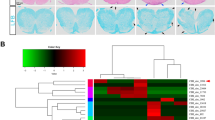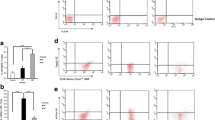Abstract
A number of different microRNAs (miRNAs) have been implicated in various autoimmune diseases, including multiple sclerosis (MS). T helper (Th)17 and regulatory T cells (Tregs) have likewise been implicated as key players in MS, and a functional imbalance of these cell types is increasingly recognized as a key etiological factor in the disease. Although specific panels of transcription factors and cytokines are known to regulate the Th17/Treg balance, the role of noncoding RNAs remains poorly understood. The inflammatory cytokine, interleukin (IL)6, appears to play a critical role in both the development of the Th17 response and the inhibition of Treg functions. In this research, an IL6-associated miRNA, miR26a, was identified, and its normally downregulated expression was shown to be highly correlated with disease severity in patients suffering from MS as well as in C57BL/6 mice with experimental autoimmune encephalomyelitis (EAE; a well-established animal model of human MS). Using the EAE model system, in vivo silencing of miR26a was found to result in increased expression of Th17-related cytokines and increased severity of EAE, while overexpression of miR26a was found to result in reduced expression of Th17-related cytokines and a milder form of EAE. By contrast, Treg cell-specific transcription factor, Foxp3, was found to be positively correlated with miR26a expression. Finally, miR26a was found to downregulate Th17 and to upregulate Treg cell function through its targeting of IL6. Taken together, our data indicate an important role for miR26a in maintaining the Th17 and Treg cell balance in MS that involves repression of IL6 expression.





Similar content being viewed by others
References
Ambros, V. (2004). The functions of animal microRNAs. Nature, 431, 350–355.
Baecher-Allan, C., & Hafler, D. A. (2004). Suppressor T cells in human diseases. The Journal of Experimental Medicine, 200, 273–276.
Baltimore, D., Boldin, M. P., O’Connell, R. M., Rao, D. S., & Taganov, K. D. (2008). MicroRNAs: New regulators of immune cell development and function. Nature Immunology, 9, 839–845.
Bettelli, E., Carrier, Y., Gao, W., Korn, T., Strom, T. B., Oukka, M., et al. (2006). Reciprocal developmental pathways for the generation of pathogenic effector TH17 and regulatory T cells. Nature, 441, 235–238.
Bielekova, B., & Martin, R. (2004). Development of biomarkers in multiple sclerosis. Brain, 127, 1463–1478.
Chen, X., Howard, O. M., & Oppenheim, J. J. (2007). Pertussis toxin by inducing IL6 promotes the generation of IL17-producing CD4 cells. The Journal of Immunology, 178, 6123–6129.
Compston, A., & Coles, A. (2008). Multiple sclerosis. Lancet, 372, 1502–1517.
Cox, M. B., Cairns, M. J., Gandhi, K. S., Carroll, A. P., Moscovis, S., Stewart, G., et al. (2010). ANZgene Multiple Sclerosis Genetics Consortium. MicroRNAs miR-17 and miR-20a inhibit T cell activation genes and are under-expressed in MS whole blood. PLoS ONE, 5, e12132.
Diveu, C., McGeachy, M. J., & Cua, D. J. (2008). Cytokines that regulate autoimmunity. Current Opinion in Immunology, 20, 663–668.
Du, C., Liu, C., Kang, J., Zhao, G., Ye, Z., & Huang, S. (2009). MicroRNA miR-326 regulates TH-17 differentiation and is associated with the pathogenesis of multiple sclerosis. Nature Immunology, 10, 1252–1259.
Ehrenstein, M. R., Evans, J. G., Singh, A., Moore, S., Warnes, G., Isenberg, D. A., et al. (2004). Compromised function of regulatory T cells in rheumatoid arthritis and reversal by anti-TNFalpha therapy. The Journal of Experimental Medicine, 200, 277–285.
Haas, J., Hug, A., Viehöver, A., Fritzsching, B., Falk, C. S., Filser, A., et al. (2005). Reduced suppressive effect of CD4 + CD25high regulatory T cells on the T cell immune response against myelin oligodendrocyte glycoprotein in patients with multiple sclerosis. European Journal of Immunology, 35, 3343–3352.
Honardoost, M. A., Kiani-Esfahani, A., Ghaedi, K., Etemadifar, M., & Salehi, M. (2014). miR-326 and miR-26a, two potential markers for diagnosis of relapse and remission phases in patient with relapsing–remitting multiple sclerosis. Gene, 544, 128–133.
Huse, J. T., Brennan, C., Hambardzumyan, D., Wee, B., Pena, J., Rouhanifard, S. H., et al. (2009). The PTEN-regulating microRNA miR-26a is amplified in high-grade glioma and facilitates gliomagenesis in vivo. Genes & Development, 23, 1327–1337.
Ivanov, I. I., McKenzie, B. S., Zhou, L., Tadokoro, C. E., Lepelley, A., Lafaille, J. J., et al. (2006). The orphan nuclear receptor RORgammat directs the differentiation program of proinflammatory IL17 + T helper cells. Cell, 126, 1121–1133.
Ji, J., Shi, J., Budhu, A., Yu, Z., Forgues, M., Roessler, S., et al. (2009). MicroRNA expression, survival, and response to interferon in liver cancer. New England Journal of Medicine, 361, 1437–1447.
Jonuleit, H., Schmitt, E., Stassen, M., Tuettenberg, A., Knop, J., & Enk, A. H. (2001). Identification and functional characterization of human CD4(+)CD25(+) T cells with regulatory properties isolated from peripheral blood. The Journal of Experimental Medicine, 193, 1285–1294.
Junker, A., Krumbholz, M., Eisele, S., Mohan, H., Augstein, F., Bittner, R., et al. (2009a). MicroRNA profiling of multiple sclerosis lesions identifies modulators of the regulatory protein CD47. Brain, 132, 3342–3352.
Junker, A., Krumbholz, M., Eisele, S., Mohan, H., Augstein, F., Bittner, R., et al. (2009b). MicroRNA profiling of multiple sclerosis lesions identifies modulators of the regulatory protein CD47. Brain, 132, 3342–3352.
Kebir, H., Ifergan, I., Alvarez, J. I., Bernard, M., Poirier, J., Arbour, N., et al. (2009). Preferential recruitment of interferon-gamma-expressing TH17 cells in multiple sclerosis. Annals of Neurology, 66, 390–402.
Keller, A., Leidinger, P., Lange, J., Borries, A., Schroers, H., Scheffler, M., et al. (2009). Multiple sclerosis: microRNA expression profiles accurately differentiate patients with relapsing-remitting disease from healthy controls. PLoS ONE, 4, e7440.
Kim, H., Huang, W., Jiang, X., Pennicooke, B., Park, P. J., & Johnson, M. D. (2010). Integrative genome analysis reveals an oncomir/oncogene cluster regulating glioblastoma survivorship. Proceedings of the National Academy of Sciences, 107, 2183–2188.
Kota, J., Chivukula, R. R., O’Donnell, K. A., Wentzel, E. A., Montgomery, C. L., Hwang, H. W., et al. (2009). Therapeutic microRNA delivery suppresses tumorigenesis in a murine liver cancer model. Cell, 37, 1005–1017.
Langrish, C. L., Chen, Y., Blumenschein, W. M., Mattson, J., Basham, B., Sedgwick, J. D., et al. (2005). IL-23 drives a pathogenic T cell population that induces autoimmune inflammation. The Journal of Experimental Medicine, 201, 233–240.
Lindberg, R. L., Hoffmann, F., Mehling, M., Kuhle, J., & Kappos, L. (2010). Altered expression of miR-17-5p in CD4 + lymphocytes of relapsing-remitting multiple sclerosis patients. European Journal of Immunology, 40, 888–898.
Lock, C., Hermans, G., Pedotti, R., Brendolan, A., Schadt, E., Garren, H., et al. (2002). Gene-microarray analysis of multiple sclerosis lesions yields new targets validated in autoimmune encephalomyelitis. Nature Medicine, 8, 500–508.
Lorenzi, J. C., Brum, D. G., Zanette, D. L., de Paula Alves Souza, A., Barbuzano, F. G., Dos Santos, A. C., et al. (2012). miR-15a and 16-1 are downregulated in CD4 + T cells of multiple sclerosis relapsing patients. International Journal of Neuroscience, 122, 466–471.
Lu, J., Getz, G., Miska, E. A., Alvarez-Saavedra, E., Lamb, J., Peck, D., et al. (2005). MicroRNA expression profiles classify human cancers. Nature, 435, 834–838.
Ma, X. T., Zhou, J., Zhong, Y., Jiang, L. I., Mu, P., Li, Y., et al. (2014). Expression, Regulation and Function of MicroRNAs in Multiple Sclerosis. International Journal of Medical Sciences, 11, 810–818.
Mucida, D., Park, Y., Kim, G., Turovskaya, O., Scott, I., Kronenberg, M., et al. (2007). Reciprocal TH17 and regulatory T cell differentiation mediated by retinoic acid. Science, 317, 256–260.
Murugaiyan, G., Beynon, V., Mittal, A., Joller, N., & Weiner, H. L. (2011a). Silencing microRNA-155 ameliorates experimental autoimmune encephalomyelitis. The Journal of Immunology, 187, 2213–2221.
Murugaiyan, G., Beynon, V., Mittal, A., Joller, N., & Weiner, H. L. (2011b). Silencing microRNA-155 ameliorates experimental autoimmune encephalomyelitis. The Journal of Immunology, 187, 2213–2221.
Nelson, P. T., Wang, W. X., & Rajeev, B. W. (2008). MicroRNAs (miRNAs) in neurodegenerative diseases. Brain Pathology, 18, 130–138.
Nishihara, M., Ogura, H., Ueda, N., Tsuruoka, M., Kitabayashi, C., Tsuji, F., et al. (2007). IL6–gp130–STAT3 in T cells directs the development of IL17 + Th with a minimum effect on that of Treg in the steady state. International Immunology, 19, 695–702.
O’Connell, R. M., Taganov, K. D., Boldin, M. P., Cheng, G., & Baltimore, D. (2007). MicroRNA-155 is induced during the macrophage inflammatory response. Proceedings of the National Academy of Sciences, 104, 1604–1609.
O’Connell, R. M., Rao, D. S., Chaudhuri, A. A., & Baltimore, D. (2010). Physiological and pathological roles for microRNAs in the immune system. Nature Reviews Immunology, 10, 111–122.
Otaegui, D., Baranzini, S. E., Armañanzas, R., Calvo, B., Muñoz-Culla, M., Khankhanian, P., et al. (2009). Differential micro RNA expression in PBMC from multiple sclerosis patients. PLoS ONE, 4, e6309.
Oukka, M. (2007). Interplay between pathogenic Th17 and regulatory T cells. Annals of the Rheumatic Diseases, 66(Suppl. 3), iii87–iii90.
Pettinelli, C. B., & McFarlin, D. E. (1981). Adoptive transfer of experimental allergic encephalomyelitis in SJL/J mice after in vitro activation of lymph node cells by myelin basic protein: Requirement for Lyt1 + 2-T lymphocytes. The Journal of Immunology, 127, 1420–1423.
Sakaguchi, S. (2005). Naturally arising Foxp3-expressing CD25 + CD4 + regulatory T cells in immunological tolerance to self and non-self. Nature Immunology, 6, 345–352.
Sander, S., Bullinger, L., Klapproth, K., Fiedler, K., Kestler, H. A., Barth, T. F., et al. (2008). MYC stimulates EZH2 expression by repression of its negative regulator miR-26a. Blood, 112, 4202–4212.
Sospedra, M., & Martin, R. (2005). Immunology of multiple sclerosis. Annual Review of Immunology, 23, 683–747.
Tiscornia, G., Singer, O., & Verma, I. M. (2006). Production and purification of lentiviral vectors. Nature Protocols, 1, 241–245.
Tzartos, J. S., Friese, M. A., Craner, M. J., Palace, J., Newcombe, J., Esiri, M. M., et al. (2008). Interleukin-17 production in central nervous system-infiltrating T cells and glial cells is associated with active disease in multiple sclerosis. The American Journal of Pathology, 172, 146–155.
Windhagen, A., Newcombe, J., Dangond, F., Strand, C., Woodroofe, M. N., Cuzner, M. L., et al. (1995). Expression of costimulatory molecules B7-1 (CD80), B7-2 (CD86), and interleukin 12 cytokine in multiple sclerosis lesions. The Journal of Experimental Medicine, 182, 1985–1996.
Xiao, C., & Rajewsky, K. (2009). MicroRNA control in the immune system: Basic principles. Cell, 136, 26–36.
Zhang, R., Tian, A., Zhang, H., Zhou, Z., Yu, H., & Chen, L. (2011). Amelioration of experimental autoimmune encephalomyelitis by β-elemene treatment is associated with Th17 and Treg cell balance. Journal of Molecular Neuroscience, 44, 31–40.
Zhu, S., Pan, W., Song, X., Liu, Y., Shao, X. R., Tang, Y. J., et al. (2012). The microRNA miR-23b suppresses IL-17-associated autoimmune inflammation by targeting TAB 2, TAB 3 and IKK-alpha. Nature Medicine, 18, 1077–1086.
Acknowledgments
The work was supported by grants from the National Natural Science Foundation of China (No. 81100889), the Liaoning Province Scientific Research Foundation for Doctors, China (No. 20111106), and the Liaoning Province Nature Science Foundation, China (No. 2012225021-73).
Conflict of interest
The authors declare that they have no conflict of interests.
Author information
Authors and Affiliations
Corresponding author
Rights and permissions
About this article
Cite this article
Zhang, R., Tian, A., Wang, J. et al. miR26a Modulates Th17/Treg Balance in the EAE Model of Multiple Sclerosis by Targeting IL6. Neuromol Med 17, 24–34 (2015). https://doi.org/10.1007/s12017-014-8335-5
Received:
Accepted:
Published:
Issue Date:
DOI: https://doi.org/10.1007/s12017-014-8335-5




